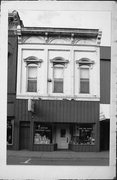| Additional Information: | The Canfield Building was erected in 1877 by E. Canfield who was a local grocer in Sparta in the 1870s, one of a number of groceries that served Sparta at this time. Thereafter, different groceries continued in the building, including the H. Stringham in the 1880s. The Stringham family operated this grocery perhaps until 1894. By 1904, A.J. Carnahan took over the grocery business at this location. By 1916, the building was the home of retail shops and continued to be used by unknown retail shops thereafter.
The Canfield Building gains local significance under Criterion A as an example of the general mercantile businesses common in the late ninteenth and early twentieth centuries. As indicated within the Commercial Theme, these enterprises (groceries, hardware stores, boot and shoe stores, etc.) played a central role in the growth and stability of the community's business. The period of historical significance extends from 1877 to perhaps as late as 1904, when the last documented grocery was located in this building.
This two-story, three-bay Italianate styled commercial building is characterized by a wide projecting iron cornice decorated by brackets and by round blind arches articulated by keystones and raised moulding on the freize panel of the entablature. The facade is further articulated by three recessed bays on the upper story that enframe three single segmental arched windows. The three long, narrow windows [rectangular windows in arched sashes] are ornamented by iron window heads featuring cornices resting on consoles and topped by arched pediments. The present storefront is a contemporary front constructed of vertical siding that covers the entire lower story with a recessed entrance to the main floor and a door to the upper story on the south end.
This early commercial building has been altered mainly by the addition of a contemporary storefront that is not compatible with its historic character and by the addition of replacement metal windows on its upper story. When this building was purchased from Stringham by F.C. Thome in 1914, this building received a new concrete basement, replacing the stone basement constructed by John Sharp in 1877. At the same time, the floor was lowered to the sidewalk and a new storefront was added to the building. The work was done by Joe Teasdale.
Constructed in 1877, this building was built at the same time as the remainder of the buildings on the block south to Oak Street [120 (MO23/35), 122 (MP23/34), and 126 (MO23/33) South Water Street]. This small commercial building was built for E. Canfield, who sold the building in 1890 to his tenant, Mrs. Stringham, the owner of the grocery store on the premises. The building was originally used to house Canfield's Grocery and Willow Ware Store, operated in partnership with George Palmer.
The Canfield Grocery and Willow Ware Store is significant under Criterion C as an example of the Italianate style. This small commercial building is among the best preserved of the 13 examples of the Commercial Italianate style in the proposed Water Street Historic District. Other well-preserved examples are located at 120 South Water (MP23/35), 117 East Oak (MO35/20), and 144 North Water (MP36/14). |
|---|
| Bibliographic References: | (A) Sparta Herald May 15, 1877; Aug. 28, 1877; Sept. 23, 1890; June 16, 1914.
(B) City of Sparta Tax Records, 1876-1930.
(C) Sanborn Insurance Maps 1884, 1889, 1894, 1900, 1911, 1922, 1931.
(D) City of Sparta Property Tax Rolls, 1870-1940.
(E) Map of Sparta, Wisconsin. Milwaukee: Phoenix Map Company of Milwaukee, 1875.
(F) French, Bella, "History of Sparta, Wisconsin." The American Sketchbook. La Crosse: Sketch Book Company, Publishers, 1875, p. 70-74.
(G) Sparta City Directory, 1903-1904. Sparta: R.C. Glover, Publisher, 1904.
(H) City Directory of the City of Sparta, Wisconsin. Sparta: compiled and published by E.B. Bell, 1916. |
|---|

